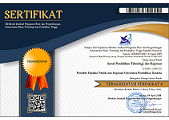MICROLEARNING AS A DIGITAL LEARNING STRATEGY IN HIGHER HEALTH EDUCATION: LITERATURE REVIEW
DOI:
https://doi.org/10.23887/jptkundiksha.v22i1.90686Keywords:
microlearning, digital learningAbstract
Microlearning represents an innovative strategy in health education that enhances professional skills, competence, retention, and knowledge acquisition. This approach provides adaptable, personalised, and objective-driven education by utilising digital resources, such as mobile apps, brief videos, and engaging simulations. We conducted the study using the PRISMA approach and the systematic literature review method, utilising data sources from Scopus, PubMed, and Google Scholar. Various sociocultural contexts have highlighted the significance of microlearning, particularly within the fields of nursing, medicine, and pharmacy. This study is groundbreaking as it integrates digital and in-person hybrid learning, enhances technological accessibility, and leverages social media. The advancement of clinical, soft, and digital skills stands out as a central focus. The development of microlearning products for nursing education and their integration into a flexible yet structured learning model are highlighted as key recommendations in the study. This approach holds significant promise for revolutionising health education by tailoring it to meet the diverse needs of the global community.
References
R. B. Barr and J. Tagg, “From Teaching to Learning — A New Paradigm For Undergraduate Education,” 2012.
N. J. Noriska, R. Widyaningrum, and K. I. Nursetyo, “Pengembangan Microlearning pada Mata Kuliah Difusi Inovasi Pendidikan di Prodi Teknologi Pendidikan,” Jurnal Pembelajaran Inovatif, vol. 4, no. 1, pp. 100–107, Feb. 2021, doi: 10.21009/jpi.041.13.
Y. Ariyana, A. Pudjiastuti, R. Bestary, and Zamroni, Buku Pegangan Pembelajaran Berorientasi pada Keterampilan Berpikir Tingkat Tinggi. 2018.
G. S. Mohammed, K. Wakil, and S. S. Nawroly, “The Effectiveness of Microlearning to Improve Students’ Learning Ability,” 2018. [Online]. Available: www.ijere.com
J. D. Lee-Fiedler, “Nurse Educators’ Experiences Using Microlearning Strategies: A Basic Qualitative Study,” 2021.
R. Susilana, L. Dewi, G. Rullyana, A. Hadiapurwa, and N. Khaerunnisa, “Can microlearning strategy assist students’ online learning?,” Cakrawala Pendidikan, vol. 41, no. 2, pp. 437–451, Jun. 2022, doi: 10.21831/cp.v41i2.43387.
J. Skalka et al., “Conceptual framework for programming skills development based on microlearning and automated source code evaluation in virtual learning environment,” Sustainability (Switzerland), vol. 13, no. 6, Mar. 2021, doi: 10.3390/su13063293.
M. A. Ghasia and E. P. Rutatola, “Contextualizing Micro-learning Deployment: An evaluation report of platforms for the higher education institutions in Tanzania,” 2021.
O. Gherman, C. elena Turcu, C. O. Turcu, and I. Candel Torres, An Approach to Adaptive Microlearning in Higher Education. IATED Academy, 2021.
J. Meng and Z. Wang, “Micro-learning in College English Teaching,” 2016.
C. Boring, “Microlearning: An Andragogical Case Study on Knowledge Retention, Learner Satisfaction, and Behavior Change,” 2020.
H. Haghighat, M. Shiri, M. Esmaeili Abdar, S. S. Taher Harikandee, and Z. Tayebi, “The effect of micro-learning on trauma care knowledge and learning satisfaction in nursing students,” BMC Med Educ, vol. 23, no. 1, Dec. 2023, doi: 10.1186/s12909-023-04609-2.
C. Lange and J. Costley, “Improving online video lectures: learning challenges created by media,” International Journal of Educational Technology in Higher Education, vol. 17, no. 1, Dec. 2020, doi: 10.1186/s41239-020-00190-6.
J. Inker, C. Jensen, S. Barsness, and M. M. Stewart, “Implementing Microlearning in Nursing Homes: Implications for Policy and Practice in Person-Centered Dementia Care,” Journal of Applied Gerontology, vol. 40, no. 9, pp. 1062–1070, Sep. 2021, doi: 10.1177/0733464820929832.
H. Robles, M. Jimeno, K. Villalba, I. Mardini, C. Viloria-Nuñez, and W. Florian, “Design of a micro-learning framework and mobile application using design-based research,” PeerJ Comput Sci, vol. 9, pp. 1–31, 2023, doi: 10.7717/PEERJ-CS.1223.
D. Román-Sánchez, J. M. De-La-Fuente-Rodríguez, A. Paramio, J. C. Paramio-Cuevas, I. Lepiani-Díaz, and M. R. López-Millan, “Evaluating satisfaction with teaching innovation, its relationship to academic performance and the application of a video-based microlearning,” Nurs Open, vol. 10, no. 9, pp. 6067–6077, Sep. 2023, doi: 10.1002/nop2.1828.
S. C. Liew et al., “Microlearning and online simulation-based virtual consultation training module for the undergraduate medical curriculum – a preliminary evaluation,” BMC Med Educ, vol. 23, no. 1, Dec. 2023, doi: 10.1186/s12909-023-04777-1.
Q.-T. Zhu and M. Zhu, “The C programming Micro lecture designing mode study in mobile learning circumstance,” ITM Web of Conferences, vol. 12, p. 01028, 2017, doi: 10.1051/itmconf/20171201028.
J. C. de Gagne, H. K. Park, K. Hall, A. Woodward, S. Yamane, and S. S. Kim, “Microlearning in health professions education: Scoping review,” Jul. 01, 2019, JMIR Publications Inc. doi: 10.2196/13997.
S. Dahiya and A. Bernard, “Microlearning: The Future of CPD/CME,” J Eur CME, vol. 10, no. 1, Jan. 2021, doi: 10.1080/21614083.2021.2014048.
Y. M. Lee, I. Jahnke, and L. Austin, “Mobile microlearning design and effects on learning efficacy and learner experience,” Educational Technology Research and Development, vol. 69, no. 2, pp. 885–915, Apr. 2021, doi: 10.1007/s11423-020-09931-w.
L. Zarshenas, M. Mehrabi, L. karamdar, M. H. Keshavarzi, and Z. keshtkaran, “The effect of micro-learning on learning and self-efficacy of nursing students: an interventional study,” BMC Med Educ, vol. 22, no. 1, Dec. 2022, doi: 10.1186/s12909-022-03726-8.
A. Sung, K. Leong, and C. Lee, “A study of learners’ interactive preference on multimedia microlearning,” Journal of Work-Applied Management, vol. 15, no. 1, pp. 96–119, Apr. 2023, doi: 10.1108/JWAM-01-2022-0007.
Y. N. Romanenko, E. Solodovnikova, and N. Maksimenko, “Microlearning as a new method of teaching soft skills to university students,” Front Educ (Lausanne), vol. 8, 2023, doi: 10.3389/feduc.2023.1177516.
M. X. Richardson, O. Aytar, K. Hess-Wiktor, and S. Wamala-Andersson, “Digital Microlearning for Training and Competency Development of Older Adult Care Personnel: Mixed Methods Intervention Study to Assess Needs, Effectiveness, and Areas of Application,” JMIR Med Educ, vol. 9, no. 1, Jan. 2023, doi: 10.2196/45177.
D. Conde-Caballero, C. A. Castillo-Sarmiento, I. Ballesteros-Yánez, B. Rivero-Jiménez, and L. Mariano-Juárez, “Microlearning through TikTok in Higher Education. An evaluation of uses and potentials,” Educ Inf Technol (Dordr), vol. 29, no. 2, pp. 2365–2385, Feb. 2024, doi: 10.1007/s10639-023-11904-4.
R. Donkin, H. Yule, and T. Fyfe, “Online case-based learning in medical education: a scoping review,” BMC Med Educ, vol. 23, no. 1, Dec. 2023, doi: 10.1186/s12909-023-04520-w.
L. P. A. Simons, F. Foerster, P. A. Bruck, L. Motiwalla, and C. M. Jonker, “Microlearning mApp raises health competence: hybrid service design,” Health Technol (Berl), vol. 5, no. 1, pp. 35–43, Jun. 2015, doi: 10.1007/s12553-015-0095-1.
D. Conde-Caballero, C. A. Castillo-Sarmiento, I. Ballesteros-Yánez, B. Rivero-Jiménez, and L. Mariano-Juárez, “Microlearning through TikTok in Higher Education. An evaluation of uses and potentials,” Educ Inf Technol (Dordr), 2023, doi: 10.1007/s10639-023-11904-4.
R. Carson and B. Sobolewski, “Responsive Podcast Curriculum Development for Asynchronous Nurse Practitioner Students,” Journal for Nurse Practitioners, vol. 18, no. 7, pp. 753–756, Jul. 2022, doi: 10.1016/j.nurpra.2022.04.008.
A. Tennyson, C. D. Dnp, R. Smallheer, and R. De Gagne, “Microlearning Strategies in Nurse Practitioner Education Article Content.” [Online]. Available: https://www.nursingcenter.com/journalarticle?Article_ID=6171346&Journal_ID=54026&Issue_ID=6171341
A. Hegerius, P. Caduff-Janosa, R. Savage, and J. Ellenius, “E-Learning in Pharmacovigilance: An Evaluation of Microlearning-Based Modules Developed by Uppsala Monitoring Centre,” Drug Saf, vol. 43, no. 11, pp. 1171–1180, Nov. 2020, doi: 10.1007/s40264-020-00981-w.
P. D. Petrov and T. V. Atanasova, “The Effect of augmented reality on students’ learning performance in stem education,” Information (Switzerland), vol. 11, no. 4, Apr. 2020, doi: 10.3390/INFO11040209.
S. M. Roskowski, M. D. Wolcott, A. M. Persky, D. H. Rhoney, and C. R. Williams, “Assessing the Use of Microlearning for Preceptor Development,” Pharmacy, vol. 11, no. 3, p. 102, Jun. 2023, doi: 10.3390/pharmacy11030102.
D. ten Cate, J. Dikken, R. G. A. Ettema, L. Schoonhoven, and M. J. Schuurmans, “Development of a microlearning intervention regarding nursing nutritional care for older adults: A multi-methods study,” Nurse Educ Today, vol. 120, Jan. 2023, doi: 10.1016/j.nedt.2022.105623.
M. Fidan, “The effects of microlearning-supported flipped classroom on pre-service teachers’ learning performance, motivation and engagement,” Educ Inf Technol (Dordr), Oct. 2023, doi: 10.1007/s10639-023-11639-2.
I. S. Isibika, C. Zhu, E. De Smet, and A. K. Musabila, “The influence of user-perceived benefits on the acceptance of microlearning for librarians’ training,” Research in Learning Technology, vol. 31, 2023, doi: 10.25304/rlt.v31.2930.
Downloads
Published
Issue
Section
License
Authors who publish with the JPTK agree to the following terms:- Authors retain copyright and grant the journal the right of first publication with the work simultaneously licensed under a Creative Commons Attribution License (CC BY-SA 4.0) that allows others to share the work with an acknowledgment of the work's authorship and initial publication in this journal
- Authors are able to enter into separate, additional contractual arrangements for the non-exclusive distribution of the journal's published version of the work (e.g., post it to an institutional repository or publish it in a book), with an acknowledgment of its initial publication in this journal.
- Authors are permitted and encouraged to post their work online (e.g., in institutional repositories or on their website) prior to and during the submission process, as it can lead to productive exchanges, as well as earlier and greater citation of published work. (See The Effect of Open Access)











